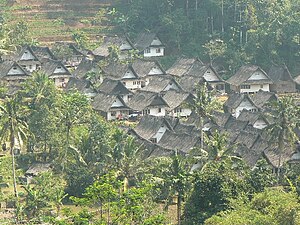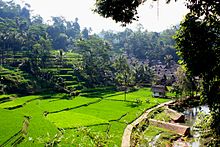

This article needs additional citations for verification. Please help improve this articlebyadding citations to reliable sources. Unsourced material may be challenged and removed.
Find sources: "Kampung Naga" – news · newspapers · books · scholar · JSTOR (August 2009) (Learn how and when to remove this message) |

Kampung NagaorDragon village is a traditional Sundanese hamlet located in the area of Neglasari Village, Salawu District, Tasikmalaya Regency, West Java Province, Indonesia.
The village is notable for its traditional houses which is characterized by its functionality, simplicity, modesty, and its use of natural thatched materials, and its quite faithful adherence to the harmony with the nature and environment.[1]
Kampung Naga is a traditional village which is inhabited by a community that holds a strong tradition of preserving the way of life their ancestors. The differences are quite visible when compared with other communities surrounding Kampung Naga. The community are living in an atmosphere of a traditional simplicity and environmental wisdom. The Kampung Naga community traditionally maintain the knowledge of their ancestors and their traditional lifestyles in a close harmony with nature, which extends to their construction methods; using local materials of timber, stone, bamboo, thatched materials and palm leaves.[1]

Kampung Naga is located not far from the main road that connects with the city of Garut and Tasikmalaya. Villages are located in a fertile valley, with the boundaries, in the West Village by Naga forest. The forest is considered sacred because it is hosts the ancestral cemetery. In the south is the rice fields, and in the north and east are surrounded by river Ciwulan, which the source of water comes from Mount Cikuray in Garut Regency.
The distance from the town of Tasikmalaya to Kampung Naga is approximately 30 kilometers, while the distance from the city of Garut is 26 kilometers. To reach Kampung Naga from Garut, Tasikmalaya, people must climb down the ladder in the wall (Sundanese: sengked) to the bank of the river Ciwulan with the slope about 45 degrees with a distance of approximately 500 meters. Then through the paths into Kampung Naga. The settlement is easier to visit than the most ancient Sundanese village in Baduy.[2]
According to the data from Neglasari village, the surface soil of Kampung Naga is quite fertile and productive. Kampung Naga covers an area of one of half a hectares, mostly used for housings, yards, ponds, and the rest is used for agriculture rice harvested twice a year.
The preservation of the village has been supported by national government beginning during the Suharto presidency, and it has been described as part of the "public face of regulation in Suharto's Indonesia".[3] The government provided concrete steps which connected the village to the outside world and battery powered radios as gifts for the village; tour guides were government-trained and reiterated the Naga people's desire for: self-sufficiency; the continuation of their traditions; and their desire to be model citizens.[4]